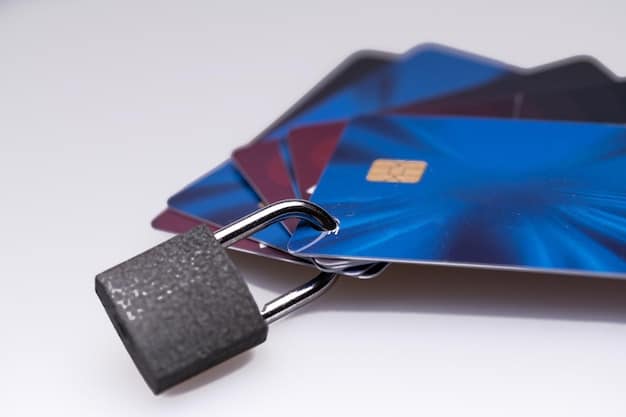Tokenization vs. Encryption: Payment Security for US E-commerce

Tokenization and encryption are crucial payment security solutions for US e-commerce platforms, each offering unique methods to protect sensitive data during transactions, but understanding their differences is key to choosing the right approach for your business.
Selecting the right payment security solution is critical for any US e-commerce platform. Two popular methods are **tokenization vs. encryption: choosing the right payment security solution for your US e-commerce platform**, but understanding their differences is crucial for protecting sensitive customer data and maintaining compliance.
Understanding Data Security in E-commerce
In the fast-paced world of e-commerce, safeguarding customer data is paramount. Data breaches can lead to significant financial losses and reputational damage, which is why US e-commerce platforms must prioritize robust security measures. Understanding the landscape of data security, including the roles of tokenization and encryption, is the first step toward building a secure payment ecosystem.
The Importance of PCI DSS Compliance
The Payment Card Industry Data Security Standard (PCI DSS) is a set of security standards designed to protect cardholder data. Compliance with PCI DSS is essential for any business that processes, stores, or transmits credit card information. Both tokenization and encryption can help businesses meet PCI DSS requirements by reducing the risk of data breaches and simplifying the compliance process.
Common Threats to E-commerce Data Security
E-commerce platforms face a variety of threats, including hacking, malware, and social engineering attacks. Cybercriminals are constantly developing new techniques to steal sensitive data, making it crucial for businesses to stay one step ahead. Implementing strong security measures, such as tokenization and encryption, can help mitigate these risks and protect customer data.
- Data breaches: Unauthorized access to sensitive data.
- Malware attacks: Malicious software designed to steal or damage data.
- Phishing scams: Fraudulent attempts to obtain sensitive information through deceptive emails or websites.
- Insider threats: Security risks posed by employees or contractors with access to sensitive data.
Data security in e-commerce is not just about technology; it’s also about implementing sound policies and procedures. Training employees on security best practices, regularly monitoring systems for vulnerabilities, and conducting security audits are all essential components of a comprehensive security program.

What is Tokenization?
Tokenization is a security process that replaces sensitive data with non-sensitive placeholders, known as tokens. These tokens can be used in place of actual data, such as credit card numbers, without compromising security. This method is particularly useful for e-commerce platforms that need to process and store payment information securely.
How Tokenization Works
When a customer enters their credit card information on an e-commerce site, the data is sent to a secure tokenization server. The server generates a unique token for the credit card number and stores the actual data in a secure vault. The token is then returned to the e-commerce site, which can use it to process the transaction without ever storing the actual credit card number.
Benefits of Tokenization
Tokenization offers several benefits for US e-commerce platforms. It reduces the risk of data breaches by ensuring that sensitive data is not stored on the e-commerce site. It also simplifies PCI DSS compliance by reducing the scope of the compliance requirements. Additionally, tokenization can improve the customer experience by allowing customers to save their payment information for future purchases without compromising security.
Consider a scenario where an e-commerce site experiences a data breach. If the site uses tokenization, the hackers would only gain access to tokens, which are useless without the actual data stored in the secure vault. This significantly reduces the potential damage from the breach.
Tokenization is a versatile security solution that can be applied to various types of sensitive data, including credit card numbers, bank account numbers, and personal identification information. Its ability to protect data without disrupting business processes makes it a valuable tool for e-commerce platforms.
What is Encryption?
Encryption is the process of converting data into an unreadable format, known as ciphertext. This ciphertext can only be decrypted back into its original form with the correct decryption key. Encryption is widely used to protect sensitive data during transmission and storage, making it a critical component of data security for US e-commerce platforms.
How Encryption Works
Encryption algorithms use complex mathematical formulas to transform data into ciphertext. The strength of the encryption depends on the length of the encryption key and the complexity of the algorithm. Strong encryption algorithms, such as Advanced Encryption Standard (AES), are virtually unbreakable without the correct decryption key.
Benefits of Encryption
Encryption provides a high level of security for sensitive data by ensuring that it is unreadable to unauthorized parties. It protects data both in transit, such as when it is being transmitted over the internet, and at rest, such as when it is stored on a server. Encryption is also required by many regulations and standards, including PCI DSS and HIPAA.
- Data protection: Ensures that sensitive data is unreadable to unauthorized parties.
- Compliance: Helps meet regulatory requirements and industry standards.
- Trust: Builds customer confidence by demonstrating a commitment to data security.
Imagine a scenario where an e-commerce site transmits customer data over the internet without encryption. Hackers could intercept the data and steal sensitive information, such as credit card numbers and personal details. Encryption prevents this by ensuring that the data is unreadable during transmission.
Encryption is a fundamental security control that should be implemented throughout the e-commerce ecosystem. From encrypting data at rest on servers to encrypting data in transit over the internet, encryption provides a vital layer of protection against data breaches and cyberattacks.

Key Differences Between Tokenization and Encryption
While both tokenization and encryption are used to protect sensitive data, they operate in different ways and offer different levels of security. Understanding the key differences between these two methods is essential for choosing the right payment security solution for your US e-commerce platform.
Data Format
Tokenization replaces sensitive data with non-sensitive tokens, which can be used in place of the actual data. Encryption transforms data into an unreadable format, which can only be decrypted with the correct decryption key. In essence, tokenization masks the data, while encryption scrambles it.
Data Storage
With tokenization, the actual data is stored in a secure vault, separate from the e-commerce site. With encryption, the encrypted data is stored on the e-commerce site or server. This means that tokenization reduces the risk of data breaches by ensuring that sensitive data is not stored on the e-commerce site, while encryption protects the data even if it is stored on the site.
Compliance
Both tokenization and encryption can help businesses meet PCI DSS compliance requirements, but tokenization can simplify the compliance process by reducing the scope of the compliance requirements. This is because tokenization ensures that sensitive data is not stored on the e-commerce site, which reduces the risk of data breaches and minimizes the compliance burden.
To illustrate, consider an e-commerce site that stores customer credit card information. If the site uses encryption, it must implement strict security measures to protect the encrypted data. If the site uses tokenization, it does not need to store the actual credit card information, which reduces the risk of data breaches and simplifies the compliance process.
Choosing between tokenization and encryption depends on the specific needs and risk profile of your US e-commerce platform. Tokenization is often preferred for its ability to reduce the risk of data breaches and simplify PCI DSS compliance, while encryption is essential for protecting data during transmission and storage.
Choosing the Right Solution for Your E-commerce Platform
Selecting the appropriate payment security solution depends on several factors, including the size of your business, the type of data you need to protect, and your compliance requirements. A thorough assessment of your security needs is essential for making an informed decision. Consider the following factors when choosing between tokenization and encryption.
Assessing Your Security Needs
Start by identifying the types of sensitive data you need to protect. This may include credit card numbers, bank account numbers, personal identification information, and other confidential data. Next, assess the risks associated with storing and transmitting this data. Consider the potential impact of a data breach on your business, including financial losses, reputational damage, and legal liabilities.
Considering PCI DSS Compliance
PCI DSS compliance is a critical consideration for any business that processes, stores, or transmits credit card information. Tokenization can simplify PCI DSS compliance by reducing the scope of the compliance requirements. Encryption is also essential for PCI DSS compliance, as it protects data during transmission and storage. Consult with a qualified security assessor to determine the best approach for meeting PCI DSS requirements.
Evaluating Costs
The cost of implementing tokenization or encryption can vary depending on the complexity of the solution and the vendor you choose. Consider the upfront costs of implementing the solution, as well as the ongoing costs of maintenance and support. Evaluate the long-term benefits of each solution, including reduced risk of data breaches and simplified compliance.
- Security needs: Identify the types of sensitive data you need to protect and the associated risks.
- PCI DSS compliance: Determine how each solution can help you meet PCI DSS requirements.
- Costs: Evaluate the upfront and ongoing costs of each solution, as well as the long-term benefits.
For example, a small e-commerce business may find that tokenization is the most cost-effective solution for protecting customer credit card information. A larger e-commerce business with more complex security needs may require a combination of tokenization and encryption to protect all sensitive data.
Ultimately, the best payment security solution is one that meets your specific needs and provides a high level of protection for sensitive data. Conduct a thorough assessment of your security needs, consider the costs and benefits of each solution, and consult with a qualified security professional to make an informed decision.
Best Practices for Implementing Payment Security Solutions
Implementing tokenization or encryption is not a one-time event; it’s an ongoing process that requires careful planning, execution, and maintenance. Following best practices for implementing payment security solutions is essential for ensuring that your US e-commerce platform remains secure and compliant.
Regular Security Audits
Conduct regular security audits to identify vulnerabilities and ensure that your security measures are effective. Security audits should be performed by qualified professionals who can assess your systems and identify potential weaknesses. Address any vulnerabilities promptly and implement corrective measures to prevent future incidents.
Employee Training
Train employees on security best practices and ensure that they understand their roles and responsibilities in protecting sensitive data. Employee training should cover topics such as password security, phishing awareness, and data handling procedures. Regular training sessions can help employees stay informed about the latest threats and security measures.
Staying Up-to-Date
Stay up-to-date with the latest security threats and technologies. Cybercriminals are constantly developing new techniques to steal sensitive data, so it’s important to stay one step ahead. Monitor security news and alerts, attend industry conferences, and consult with security experts to stay informed about the latest trends and best practices.
Consider a scenario where an e-commerce site implements tokenization but fails to conduct regular security audits. Over time, vulnerabilities may emerge that could compromise the security of the tokenization system. Regular security audits can help identify and address these vulnerabilities before they can be exploited by cybercriminals.
Implementing payment security solutions is an ongoing process that requires a commitment to security and compliance. By following best practices, conducting regular security audits, training employees, and staying up-to-date with the latest threats and technologies, you can ensure that your US e-commerce platform remains secure and protects sensitive customer data.
| Key Aspect | Brief Description |
|---|---|
| 🛡️ Data Protection | Tokenization and encryption protect sensitive data, but in different ways. |
| ✅ PCI Compliance | Both solutions help meet PCI DSS standards, but tokenization simplifies the process. |
| 💰 Cost | Costs vary; consider setup, maintenance, and long-term benefits. |
| 🔒 Implementation | Requires careful planning, regular audits, and employee training. |
FAQ
▼
Tokenization aims to replace sensitive payment data with non-sensitive tokens, reducing the risk of data breaches. This method allows transactions without exposing actual card details.
▼
Encryption transforms data into an unreadable format, ensuring that even if intercepted, the information remains secure. It requires a decryption key to revert to the original data.
▼
Tokenization often simplifies PCI DSS compliance. By not storing actual cardholder data on-site, it reduces the scope and complexity of security assessments and requirements.
▼
Consider data sensitivity, compliance needs, cost, and the level of security required. Assess risks and consult security professionals for tailored recommendations.
▼
Employee training ensures that staff understand their role in maintaining security protocols. It reduces risks from human error and enhances overall data protection effectiveness.
Conclusion
Choosing between tokenization and encryption for your US e-commerce platform is a critical decision that requires careful consideration. Both methods offer valuable security benefits, but understanding their differences and how they align with your specific needs is essential for protecting sensitive data and maintaining customer trust.





